Enterprise Culture, Innovation, and Creativity: A Detailed Analysis
VerifiedAdded on 2023/06/04
|9
|2671
|206
Essay
AI Summary
This essay examines the interconnectedness of enterprise culture, innovation, and creativity, highlighting their significance in driving economic and social development. It defines enterprise culture as the behaviors and beliefs of staff, while innovation is presented as the successful execution of novel ideas, and creativity as the ability to generate new possibilities. The essay argues that a positive enterprise culture fosters creativity and innovation by encouraging experimentation, risk-taking, and open communication. It further explains how these elements contribute to increased productivity, employee engagement, and the development of unique solutions, ultimately leading to economic growth and improved social well-being. The discussion also touches on the role of workplace innovation in addressing unforeseen challenges, such as pandemics, and ensuring organizational resilience, emphasizing the importance of cultivating a culture that values and promotes both creativity and innovation for sustained success.
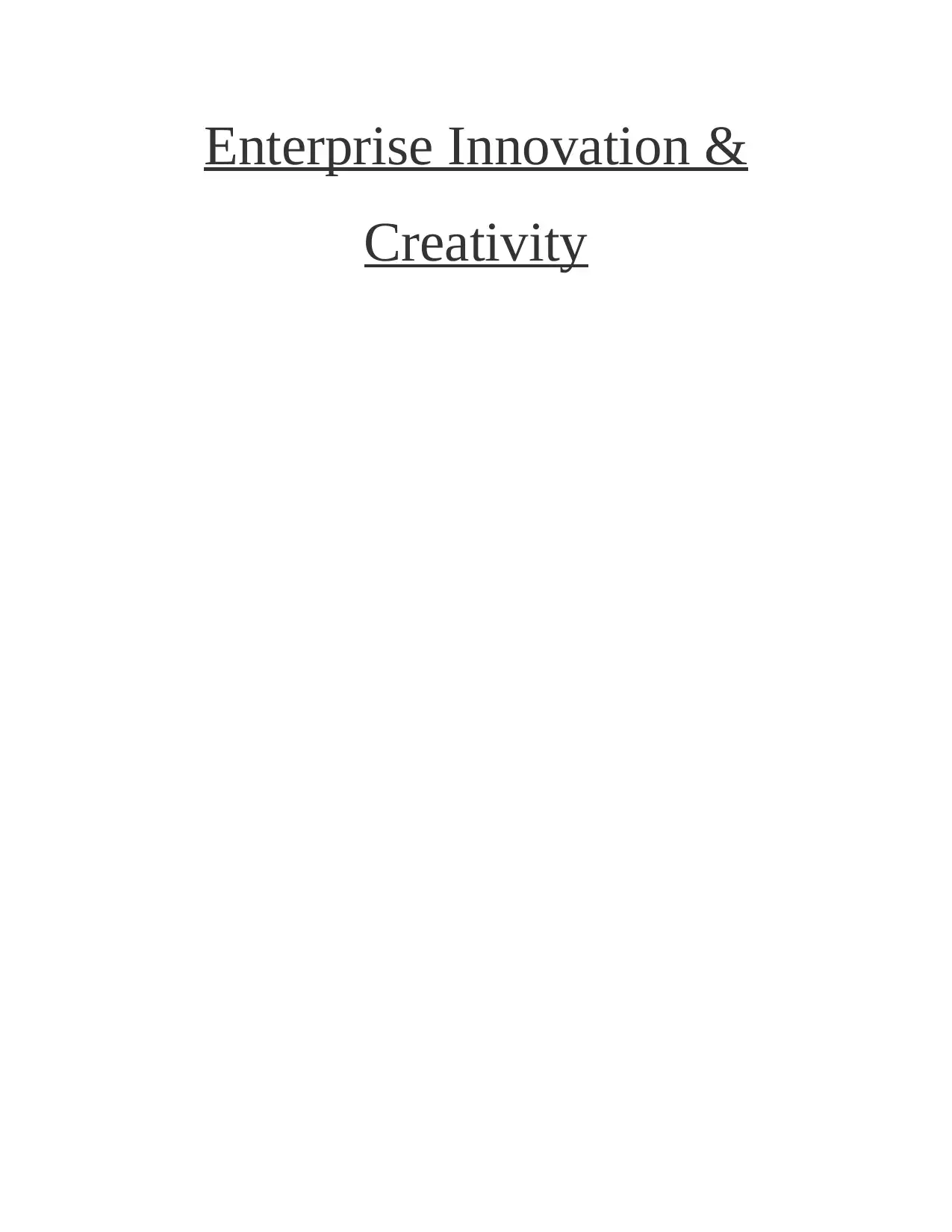
Enterprise Innovation &
Creativity
Creativity
Paraphrase This Document
Need a fresh take? Get an instant paraphrase of this document with our AI Paraphraser
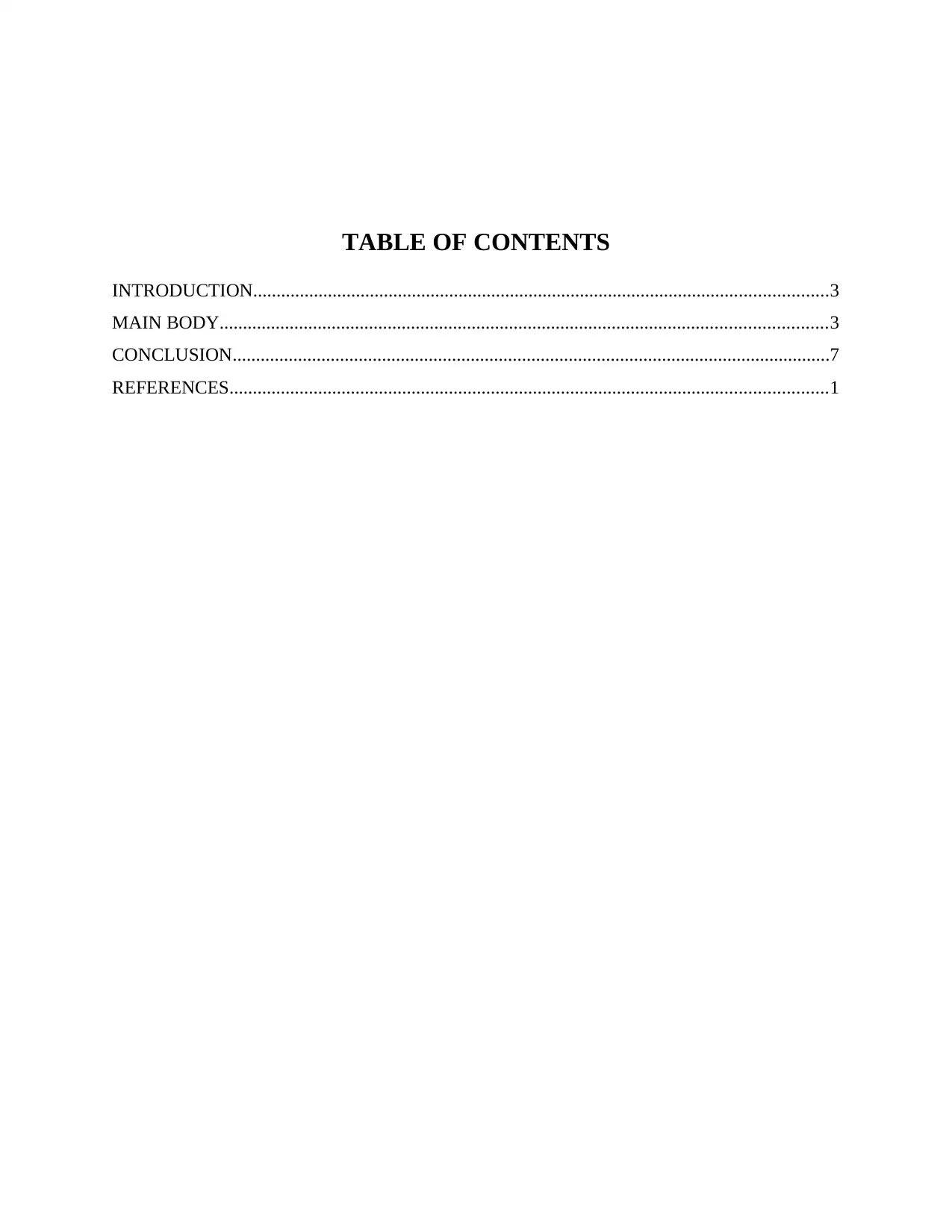
TABLE OF CONTENTS
INTRODUCTION...........................................................................................................................3
MAIN BODY..................................................................................................................................3
CONCLUSION................................................................................................................................7
REFERENCES................................................................................................................................1
INTRODUCTION...........................................................................................................................3
MAIN BODY..................................................................................................................................3
CONCLUSION................................................................................................................................7
REFERENCES................................................................................................................................1
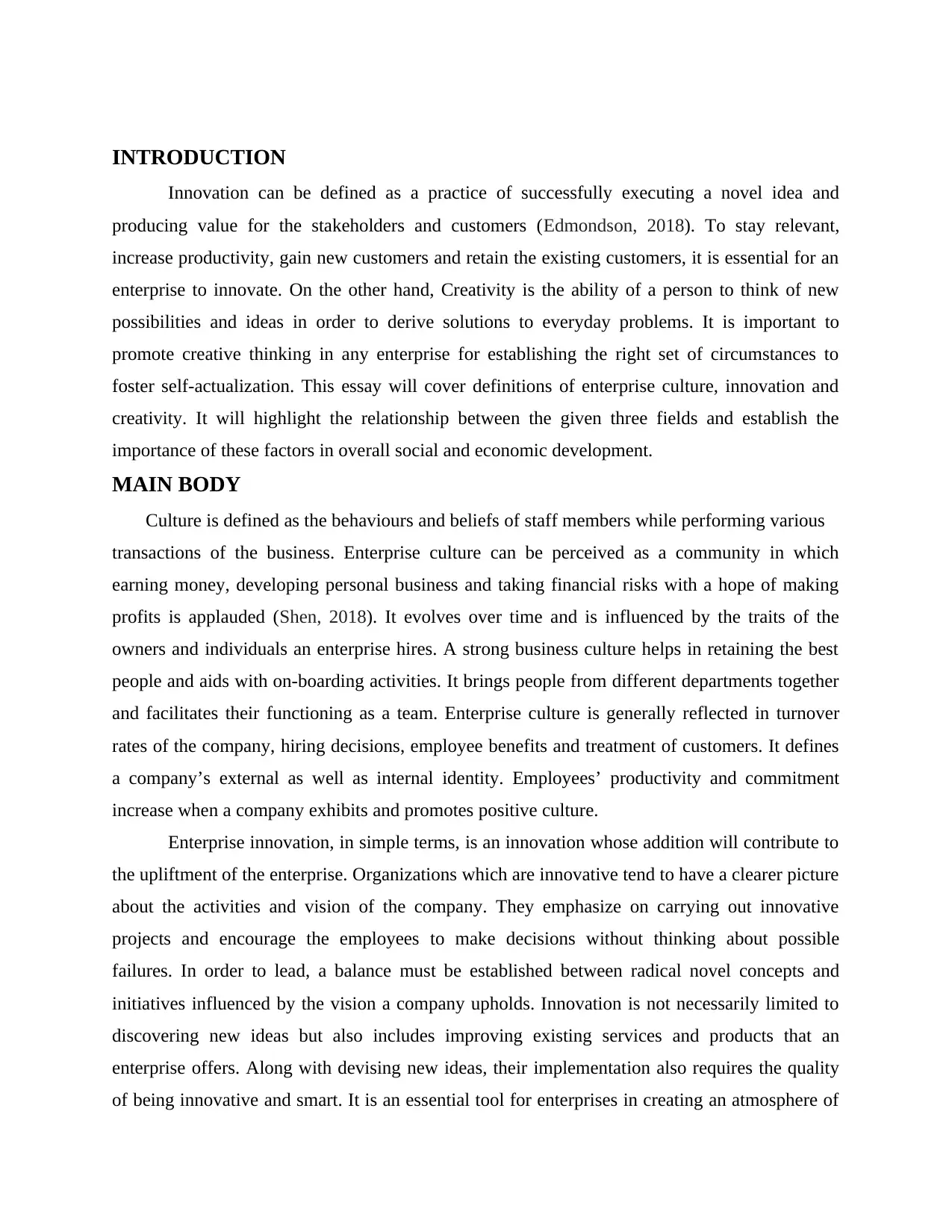
INTRODUCTION
Innovation can be defined as a practice of successfully executing a novel idea and
producing value for the stakeholders and customers (Edmondson, 2018). To stay relevant,
increase productivity, gain new customers and retain the existing customers, it is essential for an
enterprise to innovate. On the other hand, Creativity is the ability of a person to think of new
possibilities and ideas in order to derive solutions to everyday problems. It is important to
promote creative thinking in any enterprise for establishing the right set of circumstances to
foster self-actualization. This essay will cover definitions of enterprise culture, innovation and
creativity. It will highlight the relationship between the given three fields and establish the
importance of these factors in overall social and economic development.
MAIN BODY
Culture is defined as the behaviours and beliefs of staff members while performing various
transactions of the business. Enterprise culture can be perceived as a community in which
earning money, developing personal business and taking financial risks with a hope of making
profits is applauded (Shen, 2018). It evolves over time and is influenced by the traits of the
owners and individuals an enterprise hires. A strong business culture helps in retaining the best
people and aids with on-boarding activities. It brings people from different departments together
and facilitates their functioning as a team. Enterprise culture is generally reflected in turnover
rates of the company, hiring decisions, employee benefits and treatment of customers. It defines
a company’s external as well as internal identity. Employees’ productivity and commitment
increase when a company exhibits and promotes positive culture.
Enterprise innovation, in simple terms, is an innovation whose addition will contribute to
the upliftment of the enterprise. Organizations which are innovative tend to have a clearer picture
about the activities and vision of the company. They emphasize on carrying out innovative
projects and encourage the employees to make decisions without thinking about possible
failures. In order to lead, a balance must be established between radical novel concepts and
initiatives influenced by the vision a company upholds. Innovation is not necessarily limited to
discovering new ideas but also includes improving existing services and products that an
enterprise offers. Along with devising new ideas, their implementation also requires the quality
of being innovative and smart. It is an essential tool for enterprises in creating an atmosphere of
Innovation can be defined as a practice of successfully executing a novel idea and
producing value for the stakeholders and customers (Edmondson, 2018). To stay relevant,
increase productivity, gain new customers and retain the existing customers, it is essential for an
enterprise to innovate. On the other hand, Creativity is the ability of a person to think of new
possibilities and ideas in order to derive solutions to everyday problems. It is important to
promote creative thinking in any enterprise for establishing the right set of circumstances to
foster self-actualization. This essay will cover definitions of enterprise culture, innovation and
creativity. It will highlight the relationship between the given three fields and establish the
importance of these factors in overall social and economic development.
MAIN BODY
Culture is defined as the behaviours and beliefs of staff members while performing various
transactions of the business. Enterprise culture can be perceived as a community in which
earning money, developing personal business and taking financial risks with a hope of making
profits is applauded (Shen, 2018). It evolves over time and is influenced by the traits of the
owners and individuals an enterprise hires. A strong business culture helps in retaining the best
people and aids with on-boarding activities. It brings people from different departments together
and facilitates their functioning as a team. Enterprise culture is generally reflected in turnover
rates of the company, hiring decisions, employee benefits and treatment of customers. It defines
a company’s external as well as internal identity. Employees’ productivity and commitment
increase when a company exhibits and promotes positive culture.
Enterprise innovation, in simple terms, is an innovation whose addition will contribute to
the upliftment of the enterprise. Organizations which are innovative tend to have a clearer picture
about the activities and vision of the company. They emphasize on carrying out innovative
projects and encourage the employees to make decisions without thinking about possible
failures. In order to lead, a balance must be established between radical novel concepts and
initiatives influenced by the vision a company upholds. Innovation is not necessarily limited to
discovering new ideas but also includes improving existing services and products that an
enterprise offers. Along with devising new ideas, their implementation also requires the quality
of being innovative and smart. It is an essential tool for enterprises in creating an atmosphere of
⊘ This is a preview!⊘
Do you want full access?
Subscribe today to unlock all pages.

Trusted by 1+ million students worldwide
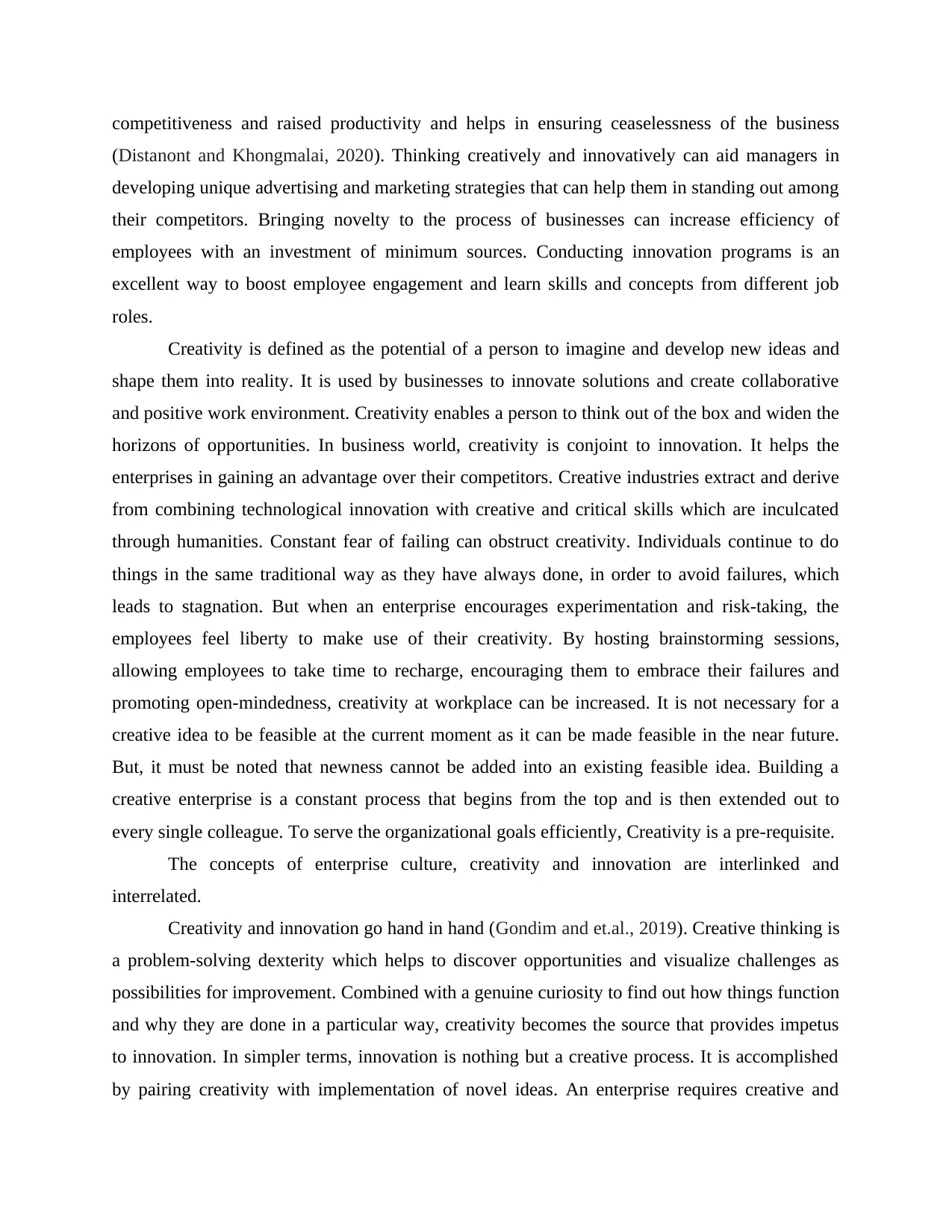
competitiveness and raised productivity and helps in ensuring ceaselessness of the business
(Distanont and Khongmalai, 2020). Thinking creatively and innovatively can aid managers in
developing unique advertising and marketing strategies that can help them in standing out among
their competitors. Bringing novelty to the process of businesses can increase efficiency of
employees with an investment of minimum sources. Conducting innovation programs is an
excellent way to boost employee engagement and learn skills and concepts from different job
roles.
Creativity is defined as the potential of a person to imagine and develop new ideas and
shape them into reality. It is used by businesses to innovate solutions and create collaborative
and positive work environment. Creativity enables a person to think out of the box and widen the
horizons of opportunities. In business world, creativity is conjoint to innovation. It helps the
enterprises in gaining an advantage over their competitors. Creative industries extract and derive
from combining technological innovation with creative and critical skills which are inculcated
through humanities. Constant fear of failing can obstruct creativity. Individuals continue to do
things in the same traditional way as they have always done, in order to avoid failures, which
leads to stagnation. But when an enterprise encourages experimentation and risk-taking, the
employees feel liberty to make use of their creativity. By hosting brainstorming sessions,
allowing employees to take time to recharge, encouraging them to embrace their failures and
promoting open-mindedness, creativity at workplace can be increased. It is not necessary for a
creative idea to be feasible at the current moment as it can be made feasible in the near future.
But, it must be noted that newness cannot be added into an existing feasible idea. Building a
creative enterprise is a constant process that begins from the top and is then extended out to
every single colleague. To serve the organizational goals efficiently, Creativity is a pre-requisite.
The concepts of enterprise culture, creativity and innovation are interlinked and
interrelated.
Creativity and innovation go hand in hand (Gondim and et.al., 2019). Creative thinking is
a problem-solving dexterity which helps to discover opportunities and visualize challenges as
possibilities for improvement. Combined with a genuine curiosity to find out how things function
and why they are done in a particular way, creativity becomes the source that provides impetus
to innovation. In simpler terms, innovation is nothing but a creative process. It is accomplished
by pairing creativity with implementation of novel ideas. An enterprise requires creative and
(Distanont and Khongmalai, 2020). Thinking creatively and innovatively can aid managers in
developing unique advertising and marketing strategies that can help them in standing out among
their competitors. Bringing novelty to the process of businesses can increase efficiency of
employees with an investment of minimum sources. Conducting innovation programs is an
excellent way to boost employee engagement and learn skills and concepts from different job
roles.
Creativity is defined as the potential of a person to imagine and develop new ideas and
shape them into reality. It is used by businesses to innovate solutions and create collaborative
and positive work environment. Creativity enables a person to think out of the box and widen the
horizons of opportunities. In business world, creativity is conjoint to innovation. It helps the
enterprises in gaining an advantage over their competitors. Creative industries extract and derive
from combining technological innovation with creative and critical skills which are inculcated
through humanities. Constant fear of failing can obstruct creativity. Individuals continue to do
things in the same traditional way as they have always done, in order to avoid failures, which
leads to stagnation. But when an enterprise encourages experimentation and risk-taking, the
employees feel liberty to make use of their creativity. By hosting brainstorming sessions,
allowing employees to take time to recharge, encouraging them to embrace their failures and
promoting open-mindedness, creativity at workplace can be increased. It is not necessary for a
creative idea to be feasible at the current moment as it can be made feasible in the near future.
But, it must be noted that newness cannot be added into an existing feasible idea. Building a
creative enterprise is a constant process that begins from the top and is then extended out to
every single colleague. To serve the organizational goals efficiently, Creativity is a pre-requisite.
The concepts of enterprise culture, creativity and innovation are interlinked and
interrelated.
Creativity and innovation go hand in hand (Gondim and et.al., 2019). Creative thinking is
a problem-solving dexterity which helps to discover opportunities and visualize challenges as
possibilities for improvement. Combined with a genuine curiosity to find out how things function
and why they are done in a particular way, creativity becomes the source that provides impetus
to innovation. In simpler terms, innovation is nothing but a creative process. It is accomplished
by pairing creativity with implementation of novel ideas. An enterprise requires creative and
Paraphrase This Document
Need a fresh take? Get an instant paraphrase of this document with our AI Paraphraser
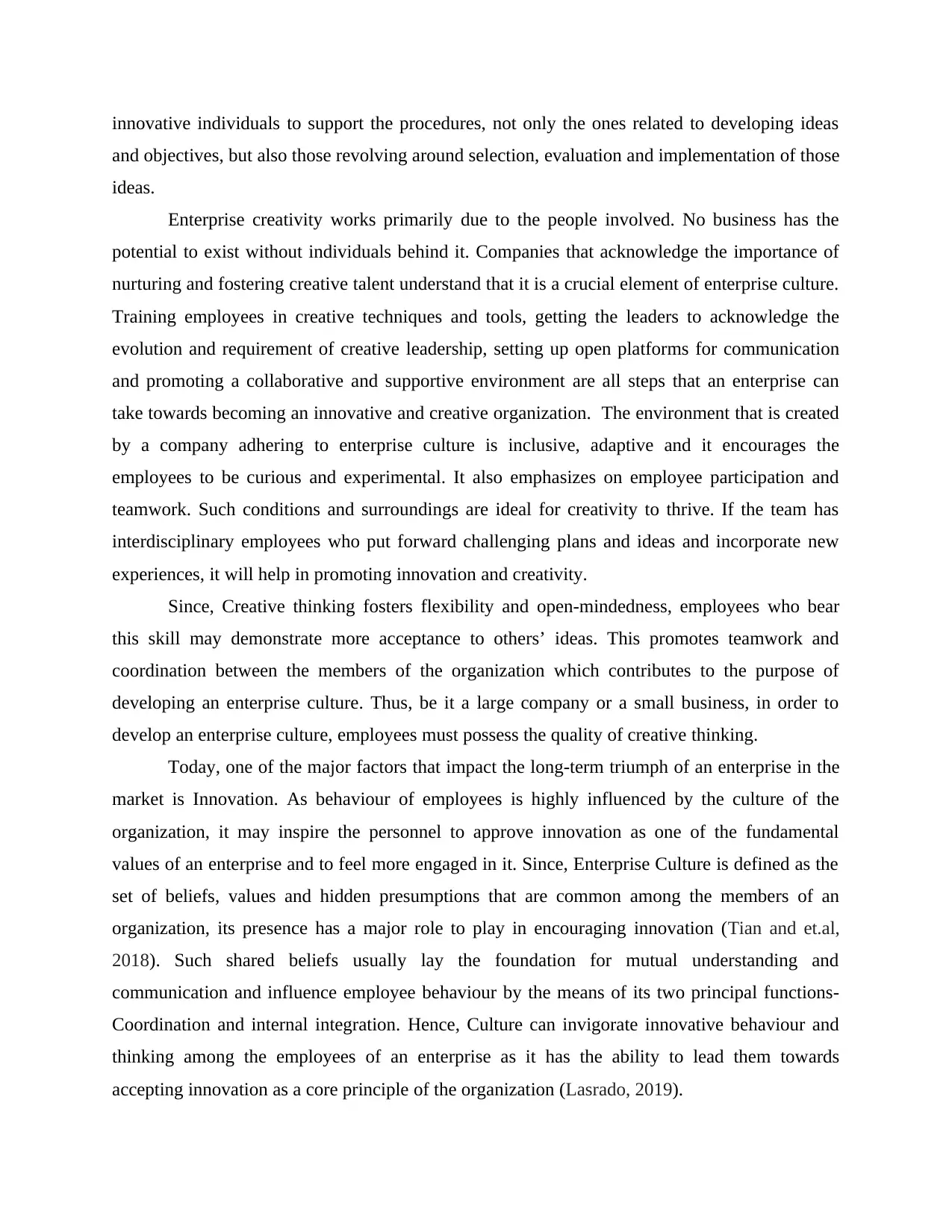
innovative individuals to support the procedures, not only the ones related to developing ideas
and objectives, but also those revolving around selection, evaluation and implementation of those
ideas.
Enterprise creativity works primarily due to the people involved. No business has the
potential to exist without individuals behind it. Companies that acknowledge the importance of
nurturing and fostering creative talent understand that it is a crucial element of enterprise culture.
Training employees in creative techniques and tools, getting the leaders to acknowledge the
evolution and requirement of creative leadership, setting up open platforms for communication
and promoting a collaborative and supportive environment are all steps that an enterprise can
take towards becoming an innovative and creative organization. The environment that is created
by a company adhering to enterprise culture is inclusive, adaptive and it encourages the
employees to be curious and experimental. It also emphasizes on employee participation and
teamwork. Such conditions and surroundings are ideal for creativity to thrive. If the team has
interdisciplinary employees who put forward challenging plans and ideas and incorporate new
experiences, it will help in promoting innovation and creativity.
Since, Creative thinking fosters flexibility and open-mindedness, employees who bear
this skill may demonstrate more acceptance to others’ ideas. This promotes teamwork and
coordination between the members of the organization which contributes to the purpose of
developing an enterprise culture. Thus, be it a large company or a small business, in order to
develop an enterprise culture, employees must possess the quality of creative thinking.
Today, one of the major factors that impact the long-term triumph of an enterprise in the
market is Innovation. As behaviour of employees is highly influenced by the culture of the
organization, it may inspire the personnel to approve innovation as one of the fundamental
values of an enterprise and to feel more engaged in it. Since, Enterprise Culture is defined as the
set of beliefs, values and hidden presumptions that are common among the members of an
organization, its presence has a major role to play in encouraging innovation (Tian and et.al,
2018). Such shared beliefs usually lay the foundation for mutual understanding and
communication and influence employee behaviour by the means of its two principal functions-
Coordination and internal integration. Hence, Culture can invigorate innovative behaviour and
thinking among the employees of an enterprise as it has the ability to lead them towards
accepting innovation as a core principle of the organization (Lasrado, 2019).
and objectives, but also those revolving around selection, evaluation and implementation of those
ideas.
Enterprise creativity works primarily due to the people involved. No business has the
potential to exist without individuals behind it. Companies that acknowledge the importance of
nurturing and fostering creative talent understand that it is a crucial element of enterprise culture.
Training employees in creative techniques and tools, getting the leaders to acknowledge the
evolution and requirement of creative leadership, setting up open platforms for communication
and promoting a collaborative and supportive environment are all steps that an enterprise can
take towards becoming an innovative and creative organization. The environment that is created
by a company adhering to enterprise culture is inclusive, adaptive and it encourages the
employees to be curious and experimental. It also emphasizes on employee participation and
teamwork. Such conditions and surroundings are ideal for creativity to thrive. If the team has
interdisciplinary employees who put forward challenging plans and ideas and incorporate new
experiences, it will help in promoting innovation and creativity.
Since, Creative thinking fosters flexibility and open-mindedness, employees who bear
this skill may demonstrate more acceptance to others’ ideas. This promotes teamwork and
coordination between the members of the organization which contributes to the purpose of
developing an enterprise culture. Thus, be it a large company or a small business, in order to
develop an enterprise culture, employees must possess the quality of creative thinking.
Today, one of the major factors that impact the long-term triumph of an enterprise in the
market is Innovation. As behaviour of employees is highly influenced by the culture of the
organization, it may inspire the personnel to approve innovation as one of the fundamental
values of an enterprise and to feel more engaged in it. Since, Enterprise Culture is defined as the
set of beliefs, values and hidden presumptions that are common among the members of an
organization, its presence has a major role to play in encouraging innovation (Tian and et.al,
2018). Such shared beliefs usually lay the foundation for mutual understanding and
communication and influence employee behaviour by the means of its two principal functions-
Coordination and internal integration. Hence, Culture can invigorate innovative behaviour and
thinking among the employees of an enterprise as it has the ability to lead them towards
accepting innovation as a core principle of the organization (Lasrado, 2019).
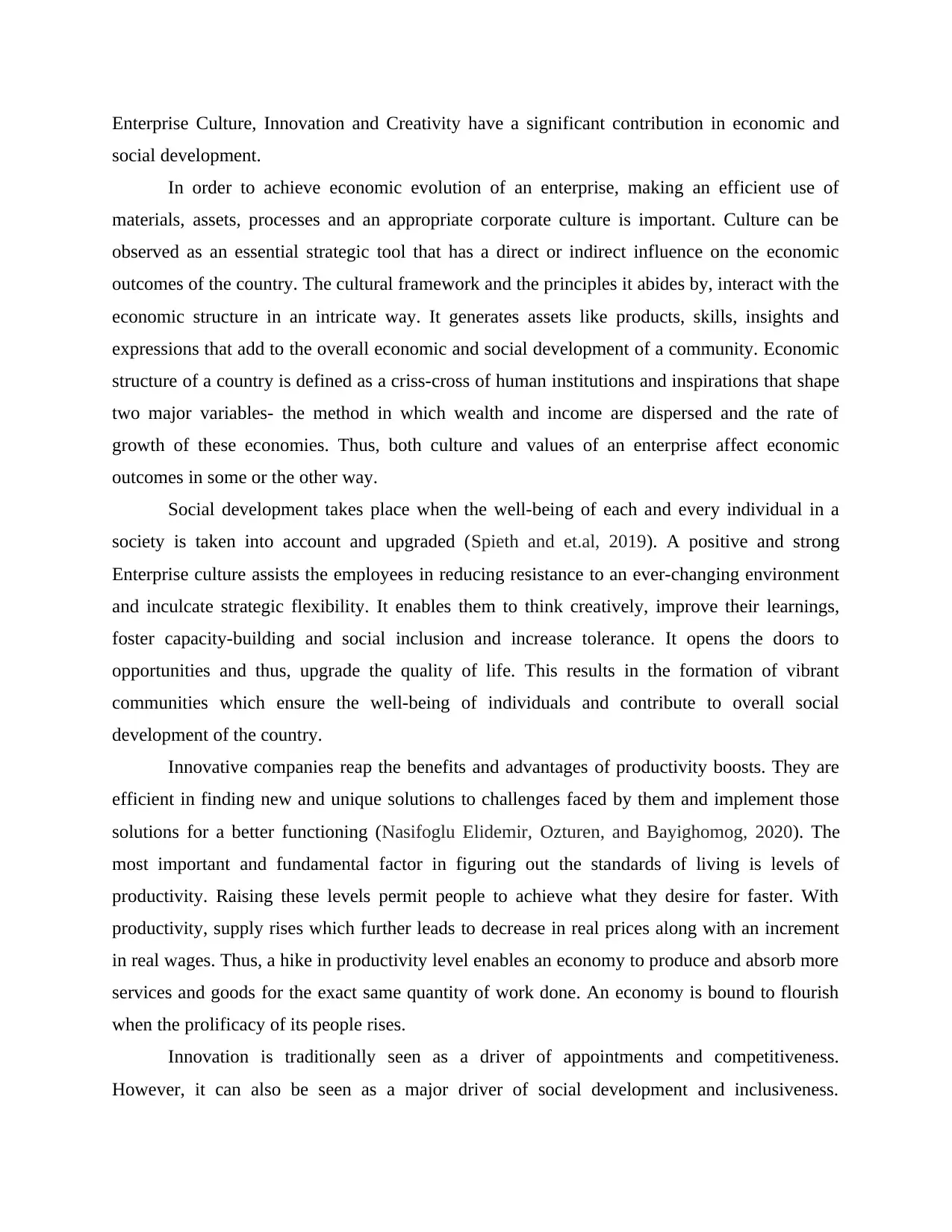
Enterprise Culture, Innovation and Creativity have a significant contribution in economic and
social development.
In order to achieve economic evolution of an enterprise, making an efficient use of
materials, assets, processes and an appropriate corporate culture is important. Culture can be
observed as an essential strategic tool that has a direct or indirect influence on the economic
outcomes of the country. The cultural framework and the principles it abides by, interact with the
economic structure in an intricate way. It generates assets like products, skills, insights and
expressions that add to the overall economic and social development of a community. Economic
structure of a country is defined as a criss-cross of human institutions and inspirations that shape
two major variables- the method in which wealth and income are dispersed and the rate of
growth of these economies. Thus, both culture and values of an enterprise affect economic
outcomes in some or the other way.
Social development takes place when the well-being of each and every individual in a
society is taken into account and upgraded (Spieth and et.al, 2019). A positive and strong
Enterprise culture assists the employees in reducing resistance to an ever-changing environment
and inculcate strategic flexibility. It enables them to think creatively, improve their learnings,
foster capacity-building and social inclusion and increase tolerance. It opens the doors to
opportunities and thus, upgrade the quality of life. This results in the formation of vibrant
communities which ensure the well-being of individuals and contribute to overall social
development of the country.
Innovative companies reap the benefits and advantages of productivity boosts. They are
efficient in finding new and unique solutions to challenges faced by them and implement those
solutions for a better functioning (Nasifoglu Elidemir, Ozturen, and Bayighomog, 2020). The
most important and fundamental factor in figuring out the standards of living is levels of
productivity. Raising these levels permit people to achieve what they desire for faster. With
productivity, supply rises which further leads to decrease in real prices along with an increment
in real wages. Thus, a hike in productivity level enables an economy to produce and absorb more
services and goods for the exact same quantity of work done. An economy is bound to flourish
when the prolificacy of its people rises.
Innovation is traditionally seen as a driver of appointments and competitiveness.
However, it can also be seen as a major driver of social development and inclusiveness.
social development.
In order to achieve economic evolution of an enterprise, making an efficient use of
materials, assets, processes and an appropriate corporate culture is important. Culture can be
observed as an essential strategic tool that has a direct or indirect influence on the economic
outcomes of the country. The cultural framework and the principles it abides by, interact with the
economic structure in an intricate way. It generates assets like products, skills, insights and
expressions that add to the overall economic and social development of a community. Economic
structure of a country is defined as a criss-cross of human institutions and inspirations that shape
two major variables- the method in which wealth and income are dispersed and the rate of
growth of these economies. Thus, both culture and values of an enterprise affect economic
outcomes in some or the other way.
Social development takes place when the well-being of each and every individual in a
society is taken into account and upgraded (Spieth and et.al, 2019). A positive and strong
Enterprise culture assists the employees in reducing resistance to an ever-changing environment
and inculcate strategic flexibility. It enables them to think creatively, improve their learnings,
foster capacity-building and social inclusion and increase tolerance. It opens the doors to
opportunities and thus, upgrade the quality of life. This results in the formation of vibrant
communities which ensure the well-being of individuals and contribute to overall social
development of the country.
Innovative companies reap the benefits and advantages of productivity boosts. They are
efficient in finding new and unique solutions to challenges faced by them and implement those
solutions for a better functioning (Nasifoglu Elidemir, Ozturen, and Bayighomog, 2020). The
most important and fundamental factor in figuring out the standards of living is levels of
productivity. Raising these levels permit people to achieve what they desire for faster. With
productivity, supply rises which further leads to decrease in real prices along with an increment
in real wages. Thus, a hike in productivity level enables an economy to produce and absorb more
services and goods for the exact same quantity of work done. An economy is bound to flourish
when the prolificacy of its people rises.
Innovation is traditionally seen as a driver of appointments and competitiveness.
However, it can also be seen as a major driver of social development and inclusiveness.
⊘ This is a preview!⊘
Do you want full access?
Subscribe today to unlock all pages.

Trusted by 1+ million students worldwide
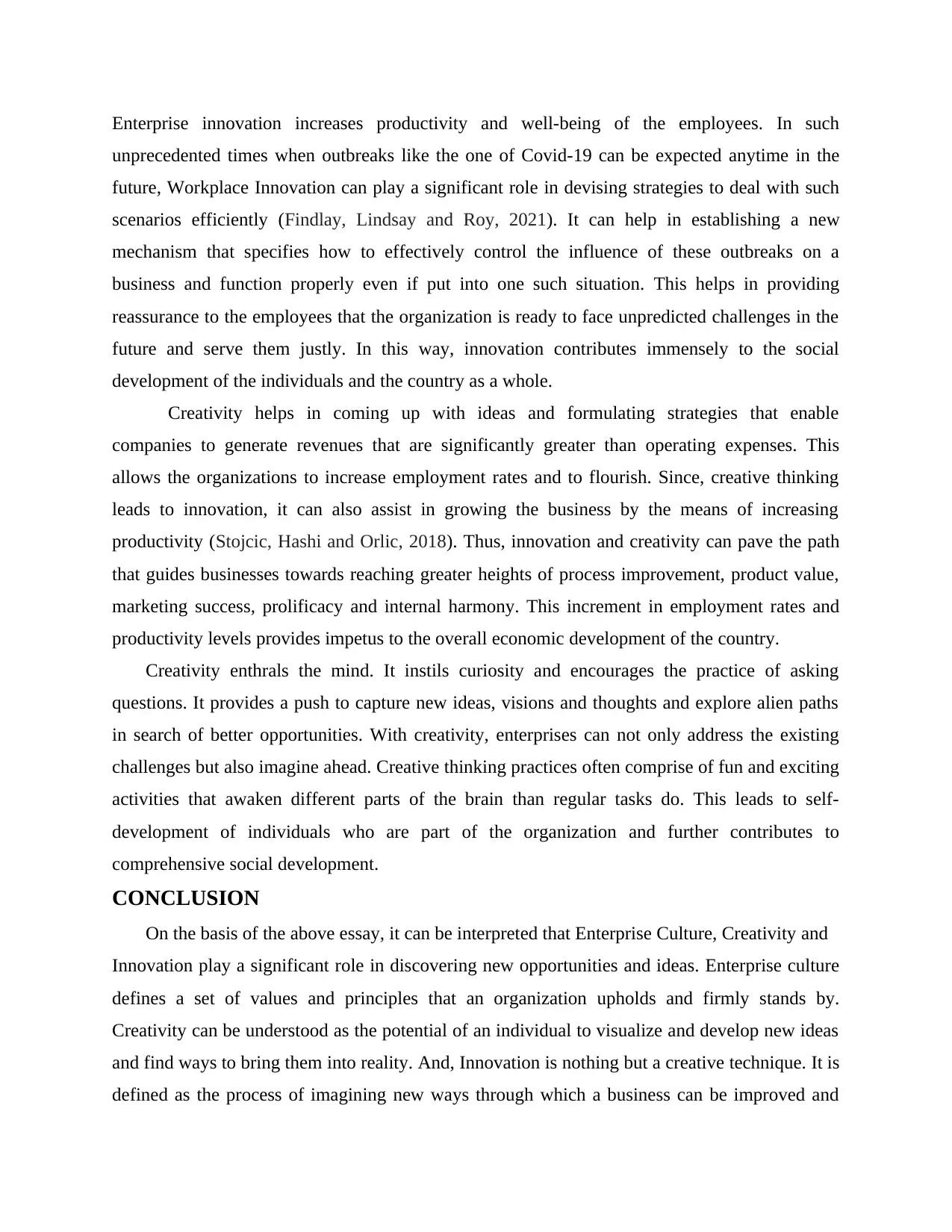
Enterprise innovation increases productivity and well-being of the employees. In such
unprecedented times when outbreaks like the one of Covid-19 can be expected anytime in the
future, Workplace Innovation can play a significant role in devising strategies to deal with such
scenarios efficiently (Findlay, Lindsay and Roy, 2021). It can help in establishing a new
mechanism that specifies how to effectively control the influence of these outbreaks on a
business and function properly even if put into one such situation. This helps in providing
reassurance to the employees that the organization is ready to face unpredicted challenges in the
future and serve them justly. In this way, innovation contributes immensely to the social
development of the individuals and the country as a whole.
Creativity helps in coming up with ideas and formulating strategies that enable
companies to generate revenues that are significantly greater than operating expenses. This
allows the organizations to increase employment rates and to flourish. Since, creative thinking
leads to innovation, it can also assist in growing the business by the means of increasing
productivity (Stojcic, Hashi and Orlic, 2018). Thus, innovation and creativity can pave the path
that guides businesses towards reaching greater heights of process improvement, product value,
marketing success, prolificacy and internal harmony. This increment in employment rates and
productivity levels provides impetus to the overall economic development of the country.
Creativity enthrals the mind. It instils curiosity and encourages the practice of asking
questions. It provides a push to capture new ideas, visions and thoughts and explore alien paths
in search of better opportunities. With creativity, enterprises can not only address the existing
challenges but also imagine ahead. Creative thinking practices often comprise of fun and exciting
activities that awaken different parts of the brain than regular tasks do. This leads to self-
development of individuals who are part of the organization and further contributes to
comprehensive social development.
CONCLUSION
On the basis of the above essay, it can be interpreted that Enterprise Culture, Creativity and
Innovation play a significant role in discovering new opportunities and ideas. Enterprise culture
defines a set of values and principles that an organization upholds and firmly stands by.
Creativity can be understood as the potential of an individual to visualize and develop new ideas
and find ways to bring them into reality. And, Innovation is nothing but a creative technique. It is
defined as the process of imagining new ways through which a business can be improved and
unprecedented times when outbreaks like the one of Covid-19 can be expected anytime in the
future, Workplace Innovation can play a significant role in devising strategies to deal with such
scenarios efficiently (Findlay, Lindsay and Roy, 2021). It can help in establishing a new
mechanism that specifies how to effectively control the influence of these outbreaks on a
business and function properly even if put into one such situation. This helps in providing
reassurance to the employees that the organization is ready to face unpredicted challenges in the
future and serve them justly. In this way, innovation contributes immensely to the social
development of the individuals and the country as a whole.
Creativity helps in coming up with ideas and formulating strategies that enable
companies to generate revenues that are significantly greater than operating expenses. This
allows the organizations to increase employment rates and to flourish. Since, creative thinking
leads to innovation, it can also assist in growing the business by the means of increasing
productivity (Stojcic, Hashi and Orlic, 2018). Thus, innovation and creativity can pave the path
that guides businesses towards reaching greater heights of process improvement, product value,
marketing success, prolificacy and internal harmony. This increment in employment rates and
productivity levels provides impetus to the overall economic development of the country.
Creativity enthrals the mind. It instils curiosity and encourages the practice of asking
questions. It provides a push to capture new ideas, visions and thoughts and explore alien paths
in search of better opportunities. With creativity, enterprises can not only address the existing
challenges but also imagine ahead. Creative thinking practices often comprise of fun and exciting
activities that awaken different parts of the brain than regular tasks do. This leads to self-
development of individuals who are part of the organization and further contributes to
comprehensive social development.
CONCLUSION
On the basis of the above essay, it can be interpreted that Enterprise Culture, Creativity and
Innovation play a significant role in discovering new opportunities and ideas. Enterprise culture
defines a set of values and principles that an organization upholds and firmly stands by.
Creativity can be understood as the potential of an individual to visualize and develop new ideas
and find ways to bring them into reality. And, Innovation is nothing but a creative technique. It is
defined as the process of imagining new ways through which a business can be improved and
Paraphrase This Document
Need a fresh take? Get an instant paraphrase of this document with our AI Paraphraser
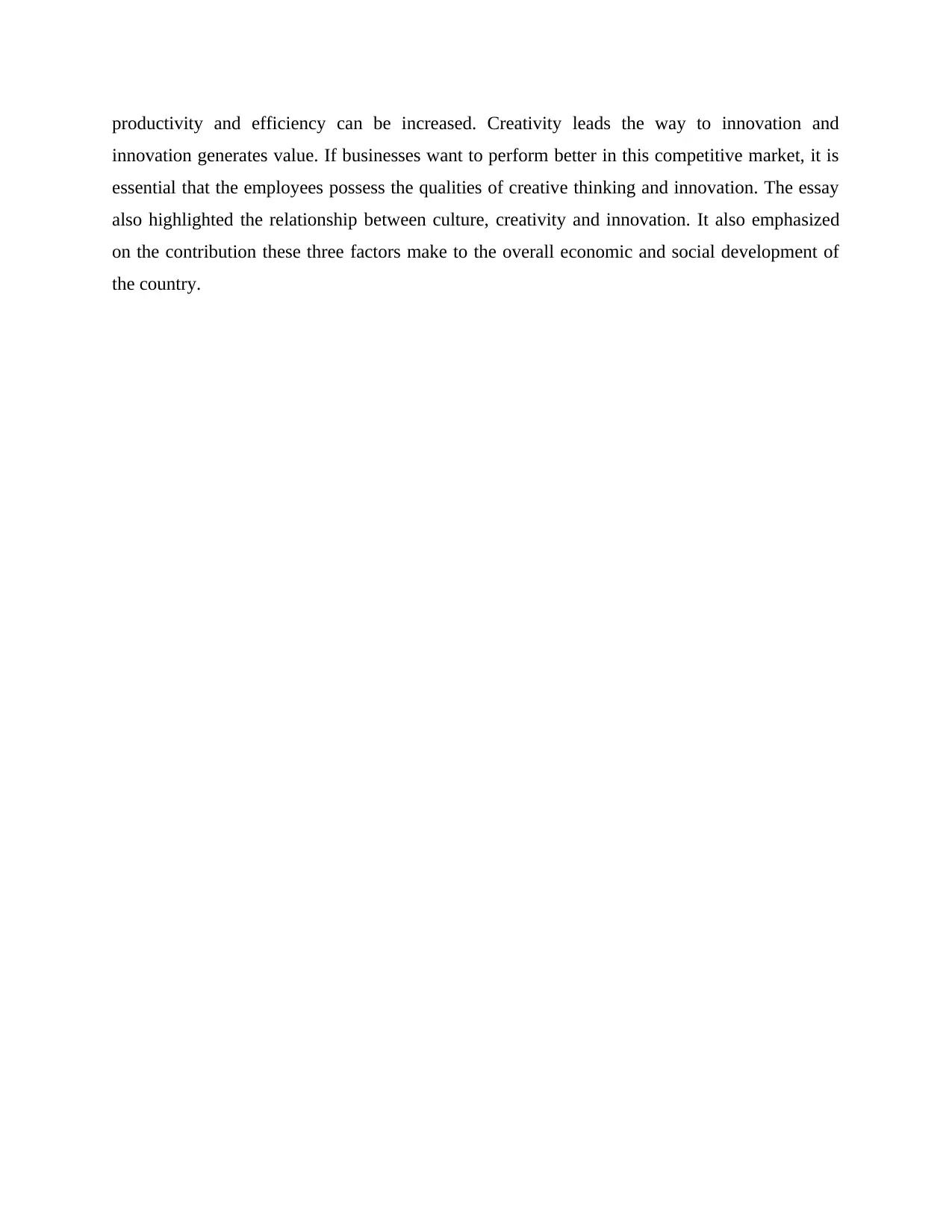
productivity and efficiency can be increased. Creativity leads the way to innovation and
innovation generates value. If businesses want to perform better in this competitive market, it is
essential that the employees possess the qualities of creative thinking and innovation. The essay
also highlighted the relationship between culture, creativity and innovation. It also emphasized
on the contribution these three factors make to the overall economic and social development of
the country.
innovation generates value. If businesses want to perform better in this competitive market, it is
essential that the employees possess the qualities of creative thinking and innovation. The essay
also highlighted the relationship between culture, creativity and innovation. It also emphasized
on the contribution these three factors make to the overall economic and social development of
the country.
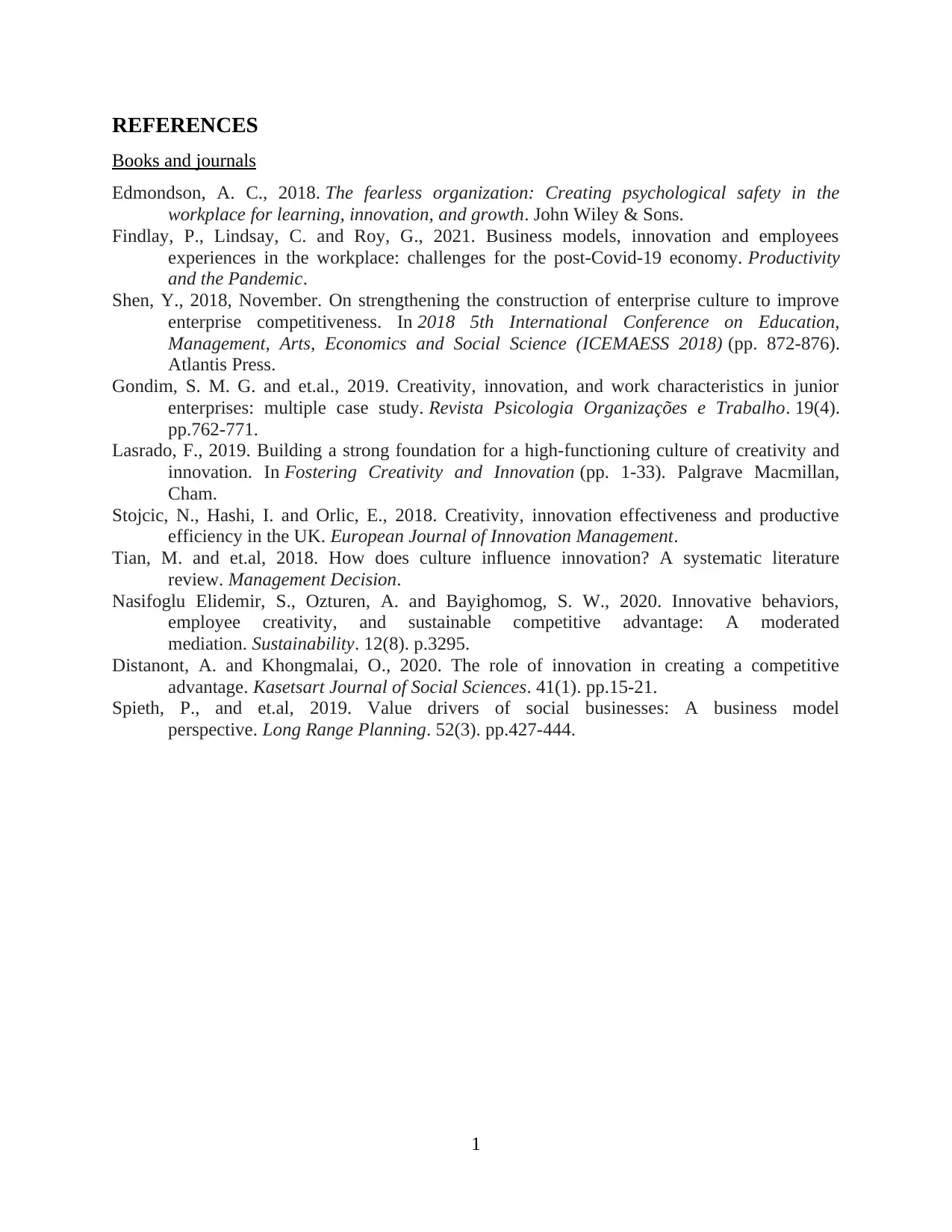
REFERENCES
Books and journals
Edmondson, A. C., 2018. The fearless organization: Creating psychological safety in the
workplace for learning, innovation, and growth. John Wiley & Sons.
Findlay, P., Lindsay, C. and Roy, G., 2021. Business models, innovation and employees
experiences in the workplace: challenges for the post-Covid-19 economy. Productivity
and the Pandemic.
Shen, Y., 2018, November. On strengthening the construction of enterprise culture to improve
enterprise competitiveness. In 2018 5th International Conference on Education,
Management, Arts, Economics and Social Science (ICEMAESS 2018) (pp. 872-876).
Atlantis Press.
Gondim, S. M. G. and et.al., 2019. Creativity, innovation, and work characteristics in junior
enterprises: multiple case study. Revista Psicologia Organizações e Trabalho. 19(4).
pp.762-771.
Lasrado, F., 2019. Building a strong foundation for a high-functioning culture of creativity and
innovation. In Fostering Creativity and Innovation (pp. 1-33). Palgrave Macmillan,
Cham.
Stojcic, N., Hashi, I. and Orlic, E., 2018. Creativity, innovation effectiveness and productive
efficiency in the UK. European Journal of Innovation Management.
Tian, M. and et.al, 2018. How does culture influence innovation? A systematic literature
review. Management Decision.
Nasifoglu Elidemir, S., Ozturen, A. and Bayighomog, S. W., 2020. Innovative behaviors,
employee creativity, and sustainable competitive advantage: A moderated
mediation. Sustainability. 12(8). p.3295.
Distanont, A. and Khongmalai, O., 2020. The role of innovation in creating a competitive
advantage. Kasetsart Journal of Social Sciences. 41(1). pp.15-21.
Spieth, P., and et.al, 2019. Value drivers of social businesses: A business model
perspective. Long Range Planning. 52(3). pp.427-444.
1
Books and journals
Edmondson, A. C., 2018. The fearless organization: Creating psychological safety in the
workplace for learning, innovation, and growth. John Wiley & Sons.
Findlay, P., Lindsay, C. and Roy, G., 2021. Business models, innovation and employees
experiences in the workplace: challenges for the post-Covid-19 economy. Productivity
and the Pandemic.
Shen, Y., 2018, November. On strengthening the construction of enterprise culture to improve
enterprise competitiveness. In 2018 5th International Conference on Education,
Management, Arts, Economics and Social Science (ICEMAESS 2018) (pp. 872-876).
Atlantis Press.
Gondim, S. M. G. and et.al., 2019. Creativity, innovation, and work characteristics in junior
enterprises: multiple case study. Revista Psicologia Organizações e Trabalho. 19(4).
pp.762-771.
Lasrado, F., 2019. Building a strong foundation for a high-functioning culture of creativity and
innovation. In Fostering Creativity and Innovation (pp. 1-33). Palgrave Macmillan,
Cham.
Stojcic, N., Hashi, I. and Orlic, E., 2018. Creativity, innovation effectiveness and productive
efficiency in the UK. European Journal of Innovation Management.
Tian, M. and et.al, 2018. How does culture influence innovation? A systematic literature
review. Management Decision.
Nasifoglu Elidemir, S., Ozturen, A. and Bayighomog, S. W., 2020. Innovative behaviors,
employee creativity, and sustainable competitive advantage: A moderated
mediation. Sustainability. 12(8). p.3295.
Distanont, A. and Khongmalai, O., 2020. The role of innovation in creating a competitive
advantage. Kasetsart Journal of Social Sciences. 41(1). pp.15-21.
Spieth, P., and et.al, 2019. Value drivers of social businesses: A business model
perspective. Long Range Planning. 52(3). pp.427-444.
1
⊘ This is a preview!⊘
Do you want full access?
Subscribe today to unlock all pages.

Trusted by 1+ million students worldwide
1 out of 9
Related Documents
Your All-in-One AI-Powered Toolkit for Academic Success.
+13062052269
info@desklib.com
Available 24*7 on WhatsApp / Email
![[object Object]](/_next/static/media/star-bottom.7253800d.svg)
Unlock your academic potential
Copyright © 2020–2025 A2Z Services. All Rights Reserved. Developed and managed by ZUCOL.





